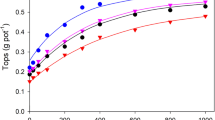Summary
A model of the way the rate of growth of a plant may be affected by the level of supply of a nutrient is presented. Growth rate is linked to the nutrient level of the photosynthetic tissues, which is assumed to control changes in the net assimilation rate, the leaf area per unit shoot weight, the shoot: root ratio, the root surface area, and the distribution of nutrient between root and shoot. The uptake of nutrient depends on the concentration of nutrient at the root surface, the root surface area and its absorbing power. All these relationships may be determined in stirred solution culture. A method of applying this information to soil grown plants is suggested.
Similar content being viewed by others
References
Baldwin J. P., Nye P. H. and Tinker P. B., Uptake of solutes by multiple root systems from soil. III. A model for calculating the solute uptake by a randomly dispersed root system developing in a finite volume of soil. Plant and Soil 38, 621–635 (1973).
Baldwin J. P. and Nye P. H., Uptake of solutes by multiple root systems from soil. IV. A model to calculate the uptake by a developing root system or root hair system of solutes with concentration variable diffusion coefficients. Plant and Soil 40, 703–706 (1974).
Bouma D., Growth changes of subteranean clover during recovery from phosphorus and sulfur stresses. Australian J. Biol. Sci., 20, 51–66 (1967).
Bouma D., Nutrient uptake and distribution in subteranean clover during recovery from nutritional stresses. 1. Experiment with phosphorus. Australian J. Biol. Sci. 20, 601–612 (1967).
Bouma D. and Dowling E. J., The physiological assessment of the nutrient status of plants II. The effect of the nutrient status of the plant with respect to phosphorus, sulfur, potassium, calcium or boron on the pattern of leaf area response following the transfer to different nutrient solutions. Australian J. Agri. Research 17, 633–46 (1966).
Brouwer R., Nutritive influences on the distribution of dry matter in the plant. Netherlands J. Agr. Sci. 10, 399–408 (1962).
Epstein E., Mineral Nutrition of Plants: Principles and Perspectives. Wiley, New York. (1972).
Evans G. C., The Quantitative Analysis of Plant Growth. Blackwell, Oxford. (1972).
Gaastra P., Climatic control of photosynthesis and respiration;in Environmental Control of Plant Growth (ed Evans L. T.) Academic Press, New York and London. (1963).
Jeffers J. N. R. (ed), Mathematical Models in Ecology. Blackwell, Oxford. (1972).
Loneragan J. F. and Snowball K., Rate of calcium absorption by plant roots and its relation to growth. Australian J. Agr. Research 20, 479–490 (1969).
Lundegardh H.,translated by Mitchell, R. L., Leaf Analysis. Hilger and Watts Ltd., London. (1951).
Olsen S. R. and Kemper W. D., Movement of nutrients to plant roots. Advances in Agronomy. 20, 91–151 (1968).
Patefield W. M. and Austin R. B., A model for the simulation of the growth ofBeta vulgaris L. Ann. Botany 35, 1227–1250 (1971).
Reid M. S. and Bieleski R., Response ofSpirodela oligorrhiza to phosphorus deficiency. Plant Physiol. 46, 609–613 (1970).
Scaife M. A. and Smith R., The phosphorus requirement of lettuce II. A dynamic model of phosphorus uptake and growth. J. Agr. Sci. (Cambridge) 80, 353–361 (1973).
Tanaka, A., Kawano, K. and Yamaguchi, J., Photosynthesis, Respiration and Plant Type of the Tropical Rice Plant. Intern. Rice Research Inst. Tech. Bull.7, (1966).
Terry N. and Ulrich A., Effects of phosphorus deficiency on the photosynthesis and respiration of leaves of sugar beet. Plant Physiol. 51, 43–47 (1973).
VanDobben W. H., Influence of temperature and light conditions on dry matter distribution, development rate and yield in arable crops. Netherlands J. Agr. Sci. 10, 377–389 (1962).
Walsh L. M. and Beaton J. D. (eds), Soil Testing and Plant Analysis. American Society of Agronomy, Madison, Wisc. (1973).
Author information
Authors and Affiliations
Additional information
Soil Science Laboratory, Department of Agricultural Science, University of Oxford
Rights and permissions
About this article
Cite this article
Nye, P.H., Brewster, J.L. & Bhat, K.K.S. The possibility of predicting solute uptake and plant growth response from independently measured soil and plant characteristics. Plant Soil 42, 161–170 (1975). https://doi.org/10.1007/BF02186982
Received:
Issue Date:
DOI: https://doi.org/10.1007/BF02186982




